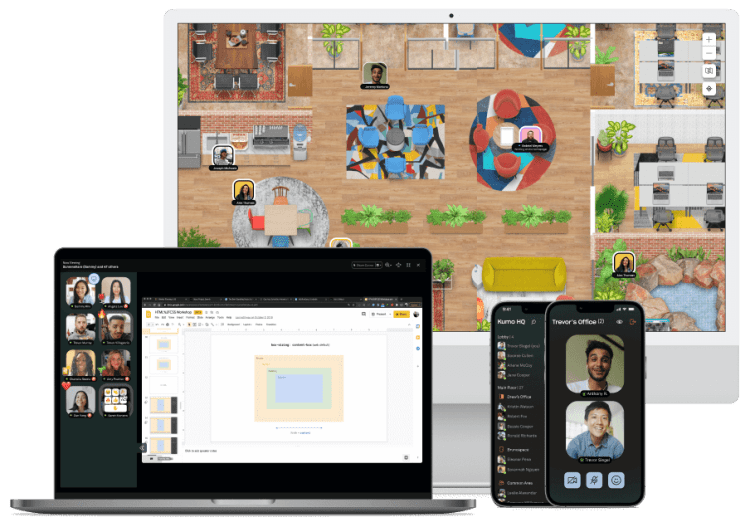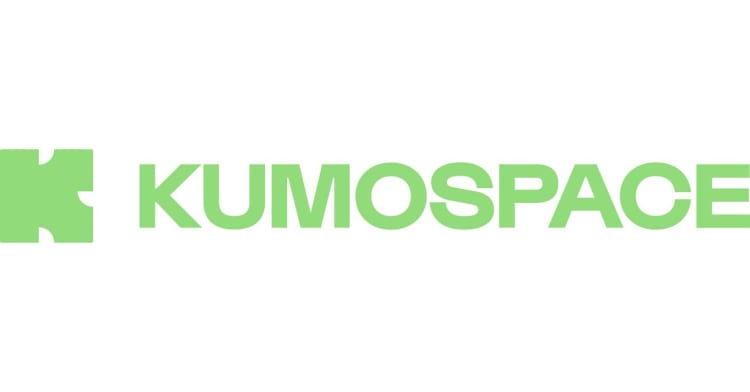With so many virtual communication platforms to choose from, how can we determine which one is the best fit for our business needs? Look no further! In this showdown, we’ll compare the popular platforms in a “Zoom vs Webex” battle, as well as introduce the innovative new contender, Kumospace. We’ll explore their features, pricing, security, and more to help you make an informed decision for your virtual communication needs.
Key takeaways
- This article provides a detailed comparison of Zoom and Webex, including their features, meeting capacity, pricing plans and security protocols.
- Both platforms offer varying levels of customer support to ensure users receive the necessary assistance for their plans.
- Kumospace is an advanced virtual communication platform with the potential to revolutionize the future of virtual communication.
Zoom vs Webex: A detailed comparison

Zoom and Webex are both video conferencing solutions, offering a variety of features that cater to different business needs. While they share key functionalities such as high-quality video and audio, meeting scheduling, and user authentication, each video conferencing platform brings unique offerings to the table. Assessing these platforms according to your unique needs and preferences will help you choose the best video conferencing software.
We will examine the video conferencing features, meeting capacity, and pricing plans of both Zoom and Webex. This will help you determine which platform is the most suitable for your business needs.
Video conferencing capabilities
Zoom and Webex both deliver HD video conferencing, but they differ in the unique features they offer. Zoom is known for its virtual backgrounds and breakout rooms, while Webex focuses on business features such as file transfer, notes, and polling. In independent tests, Zoom has been determined to have a higher video quality than Webex.
Webex offers several features, including:
- Video Mesh for on-premise video traffic bridging
- Webinar administration for attendance tracking
- An attention indicator tool
- People Insights
In terms of online video meetings, Webex, a popular video conferencing software, offers a seamless video conferencing solution with an automated system that detects if a meeting participant has a webcam running, enabling them to easily join the video conference with just a click of a button. Additionally, screen sharing capabilities enhance the collaborative experience during these meetings.
Meeting capacity and collaboration
Zoom can host up to 1,000 participants in a meeting, while Webex can accommodate up to 3,000 participants in its top-tier plans. This difference in capacity may influence your decision depending on the size of your organization and the nature of your meetings.
Collaboration features also vary between the two platforms. Zoom’s Enterprise plan offers webinars with enhanced registration and attendee networking capabilities. Webex, in contrast, provides a comprehensive range of collaboration features such as meeting transcript translation, waiting rooms, additional hosts, and complete control over participant options.
Pricing plans explored
Zoom and Webex offer a range of pricing plans, catering to businesses of different sizes. Zoom is more affordable for smaller businesses, while Webex caters to larger enterprises. You should assess the plans each provider offers, compare them, and decide whether a free plan from either platform would suit your business needs.
While Zoom provides cost-effective options for smaller businesses, it’s important to note that its free version has certain limitations, such as a 40-minute limit per meeting and a maximum of 100 participants. Webex’s free plan also offers 40 minutes of meeting time but has limited features and strict time limitations.
Security and privacy: which is more secure?

Although Webex has a stronger reputation for security, Zoom has made significant improvements to its security measures in recent years. Zoom now offers end-to-end encryption for all users and complies with GDPR, CCPA, COPPA, FERPA, and HIPAA. In response to the security concerns that surfaced during the pandemic, Zoom implemented additional meeting entry measures and robust security protocols.
Webex, with its long-standing presence as a business platform, has an esteemed reputation for outstanding security. It offers plenty of security features for meetings, including locked personal room meetings, password protection, encrypted cloud recordings, and the ability to control who enters a meeting and when.
These features offer a more secure environment for virtual communication.
User experience and ease of use

Zoom, with its easy setup and user-friendly interface, is favored by many users. Its features include:
- Easy setup
- User-friendly interface
- Format changes
- Easy member addition
- Seamless integration with G-Suite
- Zoom rooms compatibility
These features provide a smooth experience for users.
In contrast, Webex can be more complicated for beginners due to:
- Mandatory passwords and dial-in numbers
- Complex setup process
- Extended registration and check-in times
- Confusing meeting interface for those with less technical knowledge
This makes it a less user-friendly option compared to Zoom.
Advanced features face-off

Zoom and Webex both provide advanced features, though they concentrate on different areas. Zoom caters more to user experience, while Webex emphasizes business functionality. For instance, Zoom provides advanced features for webinar administration, such as attendance and attention-tracking tools. In comparison, Webex offers unlimited whiteboards for team collaboration, which is unavailable in Zoom Basic.
On the other hand, Webex provides the following features:
- Background noise removal
- Optimized voice recognition
- Gesture recognition
- Face recognition
- Real-time translation for over 100 languages
- Shape recognition in whiteboards
These features improve communication, collaboration, and productivity in online meetings, thus emphasizing business functionality.
The future of virtual communication is Kumospace

Kumospace is an innovative alternative to Zoom and Webex, providing an immersive and interactive virtual environment that replicates real-life interactions. This platform is designed to provide a highly immersive and human-like experience that surpasses traditional video calls. Users are able to move around virtual spaces, join private rooms, and interact with various interactive tools.
Kumospace has been created to prioritize security and safety, employing Single Sign-On (SSO), end-to-end encryption, and cloud storage to ensure the security of virtual communication. As a new contender in the virtual communication space, Kumospace has the potential to shape the future of virtual communication and offer a unique experience for users.
Integration with other tools

Zoom and Webex both support integrations with popular tools such as Salesforce, Microsoft Teams, and G-Suite.
However, Zoom has a larger catalog of third-party integrations, including Vimeo, Hive, Google Workspace, Slack, Eventbrite, Microsoft Teams, Notta, Google Calendar Notifications, Zapier, Fathom, Timer, Miro, and Salesforce.
You can integrate third-party tools with Zoom using Zoom Apps, which allow for effortless integration of third-party applications within the Zoom environment. Furthermore, the Zoom Video Conferencing SDK can be implemented into your website or app to enable Zoom features, offering more flexibility and options for users.
Customer support and resources

Webex provides customer support to users in different ways:
- Free users can access support through the online Help Center.
- Paid users can reach out to customer service via chat or phone.
- Enterprise customers are allocated a Webex representative who provides tailored support to them.
Zoom offers varying levels of customer support depending on the user’s plan. Here are the support options available for each plan:
- Free Zoom plan: Help Center
- Zoom Pro plan: Support tickets and live chat with a Zoom representative
- Zoom Business and Enterprise plan: Support via telephone (in addition to support tickets and live chat)
These support channels, including phone support, ensure users receive the needed assistance.
Telephone services: Zoom phone vs Webex calling

Zoom Phone and Webex Calling provide telephone services, each with distinct features and pricing options to suit different business needs. Zoom Phone offers a variety of calling plans. You can choose pay-by-the-minute or unlimited calling within the US and Canada. Metered international calling is also available to over 45 countries..
Webex’s telephony plans include:
- Call waiting
- Call forwarding
- Up to six-way conference calls
- Unlimited local and domestic long-distance
International long distance is charged per minute. The telephony services of each platform have distinct features and pricing options, requiring you to evaluate which one aligns best with your business needs.
Kumospace: The best contender

Kumospace, a fresh face in the virtual communication domain, emphasizes the creation of secure and immersive virtual spaces that mimic real-life interactions. Its spatial video chat platform encourages fluid and spontaneous conversations and strives to make virtual interactions as immersive and engaging as those in the real world.
Kumospace offers a monthly subscription plan of $7 per user, as well as a business plan of $20 per person per month for teams with more than 5 people. With its unique approach to virtual communication, Kumospace has the potential to disrupt the industry and offer a fresh alternative to traditional platforms like Zoom and Webex.
Summary
In conclusion, Zoom and Webex both offer valuable features for virtual communication, catering to different business needs. While Zoom focuses on user experience and affordability, Webex emphasizes business functionality and security. Kumospace, as a new contender, brings a fresh perspective with its immersive and interactive virtual environment. Ultimately, the choice between these platforms depends on your specific requirements and preferences, so carefully evaluate each platform to make the best decision for your virtual communication needs.
Frequently Asked Questions
Based on consumer feedback, Zoom is more user-friendly and has a flexible plan structure compared to Webex. Furthermore, it is easier to roll out and integrate into existing workspaces. Therefore, Zoom appears to be the better option.
Webex offers excellent audio and video quality, a comprehensive set of features, and a user-friendly interface, but can be cost-prohibitive for some businesses. Additionally, it may not provide the best experience when connecting with non-Webex platforms.
Webex by Cisco remains a popular video conferencing service today, with a 0.61% market share in the Online Meetings category and over 27,000 customers in 10 countries.
Kumospace offers a more innovative, secure, and immersive experience that differentiates it from Zoom and Webex, allowing for more natural and spontaneous conversations than traditional video chat platforms.





